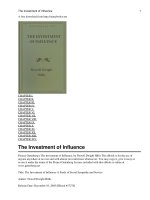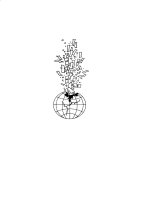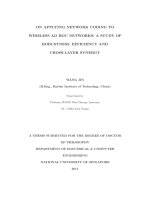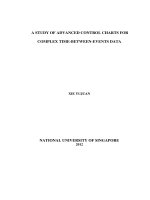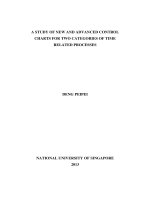A study of new and advanced control charts for two categories of time related processes
Bạn đang xem bản rút gọn của tài liệu. Xem và tải ngay bản đầy đủ của tài liệu tại đây (1.35 MB, 219 trang )
A STUDY OF NEW AND ADVANCED CONTROL
CHARTS FOR TWO CATEGORIES OF TIME
RELATED PROCESSES
DENG PEIPEI
NATIONAL UNIVERSITY OF SINGAPORE
2013
A STUDY OF NEW AND ADVANCED CONTROL
CHARTS FOR TWO CATEGORIES OF TIME
RELATED PROCESSES
DENG PEIPEI
B.Sc., University of Science and Technology of China
A THESIS SUBMITTED
FOR THE DEGREE OF DOCTOR OF PHILOSOPHY
DEPARTMENT OF INDUSTRIAL & SYSTEMS
ENGINEERING
NATIONAL UNIVERSITY OF SINGAPORE
2013
i
DECLARATION
I hereby declare that the thesis is my original work and it has been written by me
in its entirety. I have duly acknowledged all the sourced of information which
have been used in the thesis.
This thesis has also not been submitted for any degree in any university
previously.
_______________________________________
Deng Peipei
08 October 2013
ii
ACKNOWLEDGEMENTS
Foremost, I would like to express my deepest appreciation to my supervisors, Prof.
Goh Thong Ngee and Prof. Xie Min, for their continuous support, invaluable
advice, inspiring guidance and great patience throughout my Ph.D study and
research. Their enlightening advice helped me in all the way of my study and the
growth in my life.
I am deeply grateful to my senior and my friend, Dr. Xie Yujuan for her insightful
suggestions and help throughout my Ph.D life.
Besides, I want to thank National University of Singapore for offering me the
opportunity and providing me the Scholarship to study here. I want to express my
appreciation to all the faculty members at the Department of Industrial and
Systems Engineering as well for their supports.
My special thanks also goes to my fellow labmates and friends, Zhou Yuan, Liu
Hongmei, Zhou Min, Chao Ankuo, Zhong Tengyue, Yang Linchang, Tang
Muchen, Chen Liangpeng, Sheng Xiaoming, Ji Yibo and Xiao Hui at the
Department of Industrial and Systems Engineering, National University of
Singapore, for the stimulating discussions and all the fun in the last four years.
Last but not the least, I would like to express my heartfelt thanks to my parents
and all my family members for their continuous care and precious support, and
my boyfriend Yibo, for his understanding and illuminating encouragement in this
endeavour.
iii
TABLE OF CONTENTS
ACKNOWLEDGEMENTS ii
SUMMARY viii
LIST OF TABLES xi
LIST OF FIGURES xiv
LIST OF SYMBOLS xvi
CHAPTER 1 INTRODUCTION 1
1.1 CONTROL CHARTS 2
1.2 TWO CATEGORIES OF TIME-RELATED PROCESSES 4
1.2.1 Periodic Processes Monitoring 4
1.2.1 Time-between-Events Monitoring 6
1.3 RESEARCH SCOPE AND STRUCTURE OF THE STUDY 7
CHAPTER 2 LITERATURE REVIEW 10
2.1 PERIODIC PROCESS MONITORING 10
2.1.1 Periodic Processes 10
2.1.2 Cyclic Pattern 13
2.1.3 Periodic Process Extremes 14
2.1.4 Multivariate Periodic Processes 17
2.2 TIME BETWEEN EVENTS DATA MONITORING 18
2.2.1 Attribute TBE Control Charts 19
2.2.2 Variable Control Charts for TBE Data 20
2.3 TRANSFORMATIONS AND CHARTING EVALUATION 22
2.3.1 Transformation Techniques 22
2.3.2 Performance Evaluation of Control Charts 24
2.4 INNOVATIVE CONTROL CHARTS DESIGN 25
CHAPTER 3 A CIRCLE CHART FOR PERIODIC MEASUREMENTS
MONITORING 27
iv
3.1 THE BASIC CIRCLE CHART 28
3.1.1 An Illustration Example 29
3.1.2 Procedure to Plot A Circle Chart 31
3.1.3 Some Remarks 32
3.2 SOME FURTHER DEVELOPMENTS OF THE CIRCLE CHARTS 33
3.2.1 Properties of Circle Chart 33
3.2.2 Adjusting for Periodicity 34
3.2.3 Circle Chart based on Probability Limits 35
3.2.4 Normalization Transformation for Circle Chart Implementation 38
3.2.5 An Illustrative Example for Normalization Transformation 40
3.2.6 Circle Chart for Multivariate Characteristic 45
3.3 Discussions 47
CHAPTER 4 CIRCLE CHART FOR THE MONITORING OF MAXIMA
IN PERIODIC PROCESSES 48
4.1 INTRODUCTION 48
4.2 CIRCLE CHART BASED ON EXTREME VALUE DISTRIBUTION 50
4.2.1 Extreme-value Distribution and Parameter Estimation 50
4.2.2 Circle Chart Construction Procedure for Process Extremes Monitoring
51
4.2.3 An Illustrative Example 52
4.3 EXTENSIONS AND TRANSFORMATIONS 54
4.3.1 A Periodic Extreme-value distributed Model 54
4.3.2 Mean Normalization for Periodic Extreme-value Distributed Models 56
4.3.3 An Illustrative Example with Mean Normalization 57
4.4 EVALUATION OF THE PERFORMANCE OF CHARTING
PROCEDURE 61
4.4.1 ACRL Analysis of the Mean Normalization 61
4.4.2 Comparison Study 63
4.4.3 Effect of Parameter Estimation and Distribution Skewness 66
4.5 DISCUSSIONS AND CONCLUSIONS 69
v
CHAPTER 5 A CYCLIC T
2
CHART FOR MULTIVARIATE PERIODIC
MEASUREMENTS MONITORING 70
5.1 INTRODUCTION 70
5.2 A BASIC CYCLIC T
2
CHART 72
5.2.1 The Chart Construction in Phase I 72
5.2.2 The Chart Construction in Phase II 73
5.2.3 Procedure to Plot a Cyclic T
2
Chart 74
5.2.4 Illustrative Example of a Basic Cyclic T
2
Chart 75
5.3 MODIFICATIONS AND EXTENSIONS 78
5.3.1 A Multivariate Periodic Model with Seasonality 78
5.3.2 A Sequential T
2
Chart and Normalization Technique 81
5.3.3 An Illustrative Comparison Example of Several Charts 82
5.4 ACRL ANALYSIS OF CYCLIC T
2
CHARTS 87
5.5 CONCLUDING REMARKS 94
CHAPTER 6 A FULL MEWMA CHART FOR GUMBEL’S BIVARIATE
EXPONENTIALLY DISTRIBUTED DATA 96
6.1 INTRODUCTION 96
6.2 MEWMA CHART FOR GUMBEL’S BIVARIATE EXPONENTIAL
DISTRIBUTION 98
6.2.1 Bivariate Exponential Models 98
6.2.2 Inference Procedures for GBE Model 99
6.2.3 Traditional MEWMA chart for GBE data 100
6.3 MULTIVARIATE EWMA CHART WITH A FULL SMOOTHING
MATRIX 102
6.3.1 The FMEWMA Chart 102
6.3.2 The Double Square-Root Transformation 104
6.3.3 The Covariance Matrix 105
6.3.4 Illustrative Example 106
6.4 PERFORMANCE OF THE FMEWMA CHART 110
vi
6.4.1 Control Limit Selection in the Initial State and the Steady State
Monitoring 110
6.4.2 The Chart Performance under Different Distribution Dependence
Parameter 112
6.4.3 The Smoothing Parameters Selection 115
6.5 THEORETICAL ANALYSIS 116
6.5.1 Average Run Length Analysis 116
6.5.2 The Eigenvalue Analysis for Small Shifts 118
6.5.3 The Simulation Study 121
6.6 DISCUSSIONS AND CONCLUSIONS 137
CHAPTER 7 A FULL MEWMA CHART FOR TRANSFORMED
GUMBEL’S BIVARIATE EXPONENTIALLY DISTRIBUTED DATA 139
7.1 FMEWMA CHART FOR TRANSFORMED GBE DATA 141
7.1.1 The Charting Statistic 141
7.1.2 The Transformed GBE Data 143
7.1.3 Eigenvalue Table Analysis 144
7.2 GENERAL PERFORMANCE ANALYSIS AND SIMULATION STUDY
148
7.2.1 The Average Run Length Comparison and Analysis for Transformed
GBE (1, 1, 0.1) 148
7.2.2 The Average Run Length Comparison and Analysis for Transformed
GBE (1, 1, 0.9) 156
7.3 DISCUSSIONS AND CONCLUSIONS 163
CHAPTER 8 CONCLUSIONS AND DISCUSSIONS 165
8.1 SUMMARY OF CONTRIBUTIONS AND FINDINGS 165
8.1.1 Circle Chart for Periodic Processes 166
8.1.2 FMEWMA Chart for GBE data 167
8.2 DISCUSSIONS AND FUTURE WORKS 170
REFERENCES 172
vii
APPENDIX 195
viii
SUMMARY
Two categories of time-related processes monitoring are studied in this
dissertation: periodic process and time between events (TBE) data monitoring.
Periodical processes are very common and important in practical industries.
Monitoring of such processes is useful and should be investigated carefully. Due
to the fact that limited works have considered such process monitoring with
periodicity as an inherent property, a circle chart is proposed and studied for
different types of periodic processes. Individual procedure and transformation
techniques are presented in this study.
The TBE control charts are proven to be very effective in high quality
manufacturing processes monitoring. This study further considers advanced
control charts for small shifts detection: a multivariate exponentially weighted
moving average (MEWMA) control chart with a full smoothing matrix. The chart
is designed for a Gumbel’s bivariate exponential (GBE) distribution commonly
used to model practical TBE data. The principle of the chart design is to enlarge
the test statistics through the selection of off-diagonal elements under certain
shifts for the charting efficiency improvement.
The thesis consists of four parts: Chapter 1-2; Chapter 3-5; Chapter 6-7, and a
concluding Chapter 8. Chapter 1 introduces several basic concepts as well as the
foundation and motivation of this study. The research line and target is presented
in this chapter. Chapter 2 reviews many related work and shows the gap between
the existing literature and our concerned problems. Periodic process with cycle-
based signals e.g. a stamping process or a forging process, is useful and should be
monitored carefully. Direct construction of traditional control charts to monitor
such signals would either raise lots of false alarms or reduce the charting
sensitivity. Comparison between successive periods is not convenient as well.
Circle chart is proposed under such circumstances. On the other hand, study
towards the TBE data monitoring has drawn lots of attention and been developed
ix
greatly. However, study of the monitoring of multivariate cases modeled by
skewed distributions is rather limited. The MEWMA control chart with a full
smoothing matrix is extended to further improve charting efficiency towards
small shifts detection.
The second part focuses on the study of circle chart construction, starting from
Chapter 3 to Chapter 5. Chapter 3 provides the general framework of circle chart
implementation. The chart works like a clock ticking with an out-of-control signal
detected. The length of the pointer is determined by the observed measurements,
while the radius of the control limit cycles is determined by the corresponding
control limits. Probability limits are usually applied when the distribution
information is available. Chapter 4 applies the procedure into the process maxima
monitoring modeled by the extreme value distribution which is very useful in
reliability analysis and etc. A basic circle chart is constructed first for process
with no seasonality. When acceptable seasonal pattern exists, the normalization
technique is employed to facilitate the charting. The transformation effect is
analyzed in this chapter as well. Chapter 5 further studies the monitoring of
multivariate periodic processes with a cyclic T
2
chart. Multiple related
characteristics are common and complex in practice which should be monitored
carefully. The Phase I and Phase II implementation is discussed separately due to
the fact that the test statistic follows different distributions in two phases. Similar
as Chapter 4, a basic cyclic T
2
chart is constructed for cases with no seasonality
first. The inner control limit is designed for the covariance matrix shifts while the
outer control limit is designed for both the mean vector shifts and the covariance
matrix shifts. Transformation is applied when acceptable seasonality occurs. We
analyze the effect of standardization and compare it to an alternative approach-a
sequential T
2
chart. We examine the pros and cons of the proposed method and
discuss the strength and weakness through the average cycle run length (ACRL)
analysis.
Chapter 6 and 7 considers an extension of the MEWMA chart for the multivariate
TBE data monitoring. We apply the model of GBE distribution in this study. The
x
smoothing matrix of a traditional MEWMA chart is assumed to be with equal
diagonal elements and zeros off-diagonal elements. We extend it into a full
smoothing matrix with nonzero off-diagonal elements in this study. The selection
of smoothing parameters is studied. Chapter 6 considers the construction of a
FMEWMA chart for the raw and transformed GBE data monitoring. Due to the
smoothing matrix with nonzero off-diagonal elements, the FMEWMA chart
requires additional attentions to the control limit determination in the initial state
and the steady state monitoring. The initial state control limit h for a certain in-
control ARL
0
will lead to an increased in-control ARL
0
in the steady state
monitoring. The effect of the dependence parameter δ and the smoothing
parameters r and c is studied in Chapter 6 for both the raw and transformed GBE
data monitoring. The performance evaluation is conducted under both the
eigenvalue analysis and the simulation study of the GBE(1, 1, 0.5) as illustration.
The transformation is generally considered able to improve the charting efficiency
in case 1 and case 3. Chapter 7 focuses the transformed GBE data monitoring
under different dependence parameter δ. The optimal choice of the smoothing
parameters r and c is changing with the dependence parameter. The optimal
choice of the parameter c under a certain parameter r depends on the state of the
monitoring as well. Generally, the FMEWMA chart is proven to be more efficient
in the initial state monitoring than the traditional MEWMA chart for both the raw
and transformed GBE data. The transformation improves the charting efficiency
for a FMEWMA chart in case 1 and case 3 as well. For the steady state
monitoring, the superiority range of the FMEWMA chart over the MEWMA chart
increases with the dependence parameter δ. Besides, the FMEWMA chart is apt at
detecting shift in directions of (d, d) and outperforms the traditional MEWMA
chart for both the raw and transformed GBE data in both states monitoring as well.
Chapter 8 summarizes all the findings and contributions in this dissertation.
Limitation and future working directions are discussed as well.
xi
LIST OF TABLES
Table 3.1. Daily Injuries from Traffic Accident in a Certain Area
Table 3.2. The Monthly Average of US Refiner Net Input of Crude Oil
from Year 2001 to 2004
Table 4.1. 4 Periods of Simulated Data Set from EV(10,1)
Table 4.2. Electricity Demand Data Comparison
Table 4.3. ACRL Comparison Study
Table 5.1. T
2
Statistics based on (5.4) of Four Periods
Table 5.2. Comparison of T
2
Statistics for the Raw Data and the
Transformed Data
Table 5.3. T
2
Statistics Window
Table 5.4. The ARL and ACRL Analysis of Three T
2
Charts for Single
Characteristic Shift
Table 5.5. The ARL and ACRL Analysis of Three T
2
Charts for Both
Characteristics Shift
Table 6.1. Covariance Matrix for Recursive Statistics z
Table 6.2. Illustrative Example of Setting up a FMEWMA Chart with r =
0.1 and c = 0.25
Table 6.3. The In-Control ARL Comparison between the Initial State
Monitoring and the Steady State Monitoring of the Raw Data
Table 6.4. The ARL Comparison for Different Dependence Parameter for
the Raw GBE Data Monitoring
Table 6.5. The ARL Comparison for Different Dependence Parameter for
the Transformed GBE Data Monitoring
Table 6.6. Eigenvalues for Different Choices of Parameters
Table 6.7. The ARL(I) Comparison for the Raw and Transformed GBE (1,
1, 0.5) under r = 0.1 with the Initial State h
Table 6.8. The ARL(S) Comparison for the Raw and Transformed GBE
(1, 1, 0.5) under r = 0.1 with the Initial State h
xii
Table 6.9. The ARL(I) Comparison for the Raw and Transformed GBE (1,
1, 0.5) under r = 0.1 with the Steady State h
Table 6.10. The ARL(S) Comparison for the Raw and Transformed GBE
(1, 1, 0.5) under r = 0.1 with the Steady State h
Table 6.11. The ARL(I) Comparison for the Raw and Transformed GBE (1,
1, 0.5) under r = 0.02 with the Initial State h
Table 6.12. The ARL(S) Comparison for the Raw and Transformed GBE
(1, 1, 0.5) under r = 0.02 with the Initial State h
Table 6.13. The ARL(I) Comparison for the Raw and Transformed GBE (1,
1, 0.5) under r = 0.02 with the Steady State h
Table 6.14. The ARL(S) Comparison for the Raw and Transformed GBE
(1, 1, 0.5) under r = 0.02 with the Steady State h
Table 7.1. Eigenvalues for Different Choices of Parameters after
Transformation
Table 7.2. Eigenvalues for Different Choices of Parameters for Raw Data
Monitoring
Table 7.3. The ARL(I) Comparison for the Transformed GBE (1, 1, 0.1)
under r = 0.1 with the Initial State h
Table 7.4. The ARL(S) Comparison for the Transformed GBE (1, 1, 0.1)
under r = 0.1 with the Steady State h
Table 7.5. The ARL(I) Comparison for the Transformed GBE (1, 1, 0.1)
under r = 0.02 with the Initial State h
Table 7.6. The ARL(S) Comparison for the Transformed GBE (1, 1, 0.1)
under r = 0.02 with the Steady State h
Table 7.7. The ARL(I) Comparison for the Transformed GBE (1, 1, 0.9)
under r = 0.1 with the Initial State h
Table 7.8. The ARL(S) Comparison for the Transformed GBE (1, 1, 0.9)
under r = 0.1 with the Steady State h
Table 7.9. The ARL(I) Comparison for the Transformed GBE (1, 1, 0.9)
under r = 0.02 with the Initial State h
xiii
Table 7.10. The ARL(S) Comparison for the Transformed GBE (1, 1, 0.9)
under r = 0.02 with the Steady State h
xiv
LIST OF FIGURES
Fig 1.1. A Typical Shewhart Control Chart
Fig 1.2. Map of This Study
Fig 3.1. Circle Chart for Daily Injuries in week1
Fig 3.2. Circle Chart for Daily Injuries for 4 weeks
Fig 3.3. Circle Chart for Traffic Injuries Week by Week
Fig 3.4. Circle Chart of Cycle one
Fig 3.5. Circle Chart for Whole Data Set
Fig 3.6. Shewhart Control Chart for Raw Data Monitoring
Fig 3.7. Shewhart Control Chart for Mean Normalized Data Monitoring
Fig 3.8. Shewhart Control Chart for Range Normalized Data Monitoring
Fig 3.9. Shewhart Control Chart for Min-Max Transformed Data
Monitoring
Fig 3.10. Circle Chart for Mean Normalized Data from Year 2003 to 2004
for Periods Comparison
Fig 3.11. Circle Chart for Mean Normalized Data from Year 2003 to 2004
for Successive Measurements Comparison
Fig 4.1. Circle Chart Monitoring Process Maxima of Day 1
Fig 4.2. Circle Chart Monitoring Process Maxima of Day 1 and Day 2
Fig 4.3. Circle Chart for the Raw Data under kσ Control Limits
Fig 4.4. Circle Chart for Transformed Data
Fig 4.5. The Out-of-Control ARL with the Shift Parameter ρ
Fig 4.6. β Error with Different Parameter
2 1
k k k
= −
Fig 4.7. Out-of-Control ARL Contour Plot with Different Parameters k
1
and k
2
Fig 5.1. A Cyclic T
2
Chart until the 1
st
Out-of-Control Signal
Fig 5.2. Bivariate Normal Distributions
Fig 5.3. A Cyclic T
2
Chart for the Raw Data
Fig 5.4. A Cyclic T
2
Chart for the Standardized Data
xv
Fig 6.1. FMEWMA Chart for the Initial State Raw GBE Data
Fig 6.2. FMEWMA Chart for the Initial State Transformed GBE Data
Fig 6.3. MEWMA chart with r = 0.1 for the Initial State Raw GBE Data
Fig 7.1. The Correlation Coefficient of the Raw Data and the Transformed
Data with the Dependence Parameter δ
xvi
LIST OF SYMBOLS
ACRL average cycle run length
AQI average quantity of products inspected
ARL average run length
ATS average time to signal
b scale parameter of an extreme value distribution
c ratio parameter of a full smoothing matrix
CCC cumulative count of conforming
CQC cumulative quantity control
CUSUM cumulative sum
d periodicity length
DOE Design of Experiments
EWMA exponentially weighted moving average
FMEWMA
multivariate exponentially weighted moving average with a full
smoothing matrix
GBE Gumbel’s bivariate exponential
HBW Houggard’s Bivariate Weibull
ICL Inner Control Limit
LCL Lower Control Limit
m number of samples
MEWMA multivariate exponentially weighted moving average
MR moving range
OCL Outer Control Limit
p number of characteristcs
r smoothing parameter of a full smoothing matrix
SPC Statistical Process Control
SQC Statistical Quality Control
TBE time-between-events
xvii
u location parameter of an extreme value distribution
UCL Upper Control Limit
X
i
the ith observation
α type I error or false alarm rate
β type II error
δ dependence parameter of a GBE distribution
∆ process shift size
ϕ moving angle of the circle chart pointer
1
CHAPTER 1 INTRODUCTION
Over the past century there has been rapid development in the field of statistical
quality control (SQC) which plays a vital role in the practical industries. SQC
techniques mainly consist of statistical process control (SPC), design of
experiments (DOE), acceptance sampling and capability analysis (Montgomery,
2007). Among them, SPC is aimed at monitoring and controlling output
measurements or input factors from the current process, while DOE is able to
determine significant input factors that affect the process; acceptance sampling is
closely related to inspection and testing of products; capability analysis assesses
process capability of meeting specification limits.
This research is classified as belonging to the scope of the SPC techniques
which use statistical methods to monitor and control a process. Since the year
1924 when W.A. Shewhart first introduced the control chart concept to monitor
and control a manufacturing process, SPC tools started to draw lots of attention
and have been widely developed. The seven major tools of SPC, commonly
known as “the magnificent seven”, include histogram or stem-and-leaf plot, check
sheet, cause-and-effect diagram, Pareto chart, scatter diagram, defect
concentration diagram and control chart. Control chart is the most powerful and
technically sophisticated tool among these. Following Fig 1.1 is a typical
Shewhart Control Chart from Montgomery (2007). The center line (CL) is
determined by the sample average which is often considered as the target value.
The vertical distance between the observation and the CL represents the
variability measurement. The Upper/Lower Control Limit (UCL/LCL) represents
2
the limitation for the maximum variability. If no point falls outside the control
limits, the process is considered as in-control. If any point falls outside the control
limits, investigation would be required before the process restarts.
Fig 1.1: A Typical Shewhart Control Chart
Generally, SPC measures the source of variation through control chart
implementation, eliminates assignable sources of variation, and is applicable to
any defined process with input factors, output measurements and etc.
This chapter is a brief introduction to the classification of control charts and
the motivation for this study. Section 1.1 presents the concept of control charts
and different classifications. Section 1.2 introduces the importance and the
applications of the concerned processes. Section 1.3 shows the research scope and
structure of the thesis.
1.1 CONTROL CHARTS
As aforementioned, control chart and other basic SPC fundamentals are proposed
in the 1920’s and 1930’s by Walter Shewhart. The research activity towards SPC
techniques has drawn much attention and gone through a significant growth since
1980. Control chart is regarded as one graphical representation tool which plots
specific quantitative measurements from the process with control limits to
facilitate the detection of process shift and the search for assignable causes.
3
Control charts can be classified based on the monitored characteristics into
different categories. Univariate control charts are designed for the monitoring of
single characteristic, while multivariate control charts are designed for the
monitoring of multiple related characteristics. Control charts can be classified into
variable control charts and attribute control charts as well. On the other hand,
control charts can be classified according to the purpose is either for retrospective
analysis or prospective monitoring as Phase I control charts or Phase II control
charts.
Common univariate Shewhart control charts, i.e.
X
chart, and R chart or S
chart, are for variable measurements monitoring. Many Shewhart control charts
for attributes are proposed as well, e.g. the p chart, c chart, np chart, and u chart.
Univariate control charts which are sensitive for small shift detection are
proposed as advance control charts, e.g. the Cumulative Sum (CUSUM) chart and
the Exponentially Weighted Moving Average (EWMA) chart.
For multivariate characteristics monitoring, control charts can be classified
similarly as univariate control charts. One commonly applied multivariate control
chart is the Hotelling T
2
chart (Hotelling 1947), which is the analog of the
univariate Shewhart
X
chart. The multivariate version of the CUSUM chart and
the EWMA chart are extended to provide more sensitivity to multivariate small
shifts. Many related works are reviewed in Chapter 2.
All these control charts are developed based on the normal assumption.
Control charts for processes which are characterized by other distributions were
proposed as charts with probability limits and so on. On the other hand, many
works apply transformations before the charting to transform skewed distributions
to follow a normal or near-normal distribution.
In recent years, control charts for specific processes were proposed according
to the feature of the process, e.g. time-between-events (TBE) control charts are
initially designed for high-quality manufacturing processes, etc. This study
mainly consists of two topics: circle charts designed for various types of periodic
4
processes monitoring and MEWMA charts designed for complex TBE data
monitoring via an extension of the smoothing matrix. Both categories of time-
related processes play a vital role in the practical manufacturing processes, service
industry, and reliability analysis. The next section focuses on the introduction and
application of both categories of time related processes monitoring.
1.2 TWO CATEGORIES OF TIME-RELATED PROCESSES
1.2.1 Periodic Processes Monitoring
The first type is the periodic processes which are common in practice. The natural
periodicity could be days, weeks, months or years, and could be each operation
cycle or a production cycle as well. In a manufacturing process, the repetitiveness
of operation cycles is common, e.g. a forging process or a stamping process, and
etc., see Zhou et al. (2005a), Zhou et al. (2006), and Kim et al. (2010), etc.
Moreover, the periodicity could be a demand cycle or a service period from
reliability analysis and service industries as well, see Darbellay and Slama (2000),
Rosenbaum and Sukharomana (2001), etc. Measurements from such cycles would
exhibit a certain periodicity which should be monitored and investigated carefully.
Periodic processes monitoring is one important topic, but rather limited works can
be found in the existing literature on the monitoring of such processes. This is our
motivation for developing circle chart implementation as well.
Xie et al. (2012) pointed out that the cyclic pattern in such processes is
regarded as ‘out-of-control’ signal in the conventional use of Shewhart control
charts, according to the ‘Western Electric rules’: several types of unnatural
patterns may occur in an unstable process, including cyclic, systematic, upward
shift, downward shift, increasing trend and decreasing trend patterns. Traditional
methods could either raise lots of false alarms or lose much sensitivity when
monitoring periodic processes. Monitoring techniques that consider such
periodicity as an inherent feature are required. Circle chart is proposed under such
circumstances in Xie et al. (2012).
5
Circle chart plots test statistics around a circle instead of plotting as a run chart.
The length of the charting pointer is determined by the monitored test statistics,
while the radius of the control limit cycles is determined by the corresponding
Inner Control Limit (ICL) and Outer Control Limit (OCL). Circle chart works like
a clock alarming when its pointer reaches out of the ICL cycle or the OCL cycle.
It incorporates the periodic information to facilitate decision making. Comparison
between different stages and periods can be directly perceived. The dynamic
move of the process can be presented through different colors and markers as well.
In the light of individual periodic processes, circle chart can be constructed
correspondingly. The classification of circle charts can be divided similarly as the
traditional control charts. Univariate circle chart is designed for the single
characteristic monitoring. Based on the distribution information of the monitored
process, probability limits can be constructed for the charting. Chapter 3 provides
a general framework and a brief introduction of the circle chart implementation
procedure, assuming the monitored process follows a normal distribution.
Meanwhile, an illustrative example of a circle chart for the exponential
distribution is provided. Chapter 4 provides the charting procedure and analyzes
the transformation effect of the circle chart for periodic process maxima
monitoring, using the extreme value distribution to model the process.
Furthermore, multiple characteristics monitoring from the periodic processes
requires a multivariate circle chart. Chapter 5 focuses on the construction of a
cyclic T
2
chart and the corresponding transformation techniques. The circle chart
implementation is validated by the non-negativity of the T
2
statistic as well.
The approach employed in Chapter 3, 4 and 5 is the normalization technique.
Due to the fact that seasonality often comes with the periodicity, the
normalization technique is applied to mitigate the sectional difference and
facilitate the charting procedure. Transformed process monitoring is able to reveal
a process shift clearly. In this study, a simple model is constructed to describe the
process periodicity and seasonality. The model is presented in Chapter 3 first and
could be extended to other cases, e.g. other location-scale distributions, (see
6
Chapter 4), or multivariate cases (see Chapter 5). Throughout this study, the
periodicity is assumed to be directly perceived or readily estimated.
1.2.1 Time-between-Events Monitoring
The other type is the time-between-events data monitoring. It was firstly studied
by Calvin (1983) for high-quality manufacturing processes when the occurrence
rate of nonconforming items is rather low. Goh (1987a) further popularized it.
The term “events” may refer to different definitions according to the application:
for a manufacturing process, the event could be a nonconforming item; for a
service study, the event could be a served customer; for the reliability analysis,
the event could be a failure from the system, and so on. The term “time” can refer
to attribute count or variable measure observed between consecutive events.
Consequently, the TBE control charts can be classified according to the “events”
and “time” definition as attribute TBE control chart and variable TBE control
chart. Instead of monitoring the quantity or the proportion of events occurring
during certain sampling interval, TBE charts devote the attention to the time
between consecutive events occurrence.
The cumulative count of conforming (CCC) chart is one type of attribute TBE
control chart, designed for high-quality processes with very low defective rate. In
lieu of monitoring the number or proportion of defective items in the sample, it
measures the cumulative count of conforming items between consecutive
nonconforming items. The other type of TBE control chart is variable TBE
control charts. The time measured between two consecutive events is a random
variable under such circumstances. The cumulative quantity control (CQC) chart
is a variable TBE control chart. The occurrence of events is typically modeled by
a Poisson process. Consequently, the cumulative quantity between consecutive
events follows an exponential distribution so that the CQC chart is also known as
an exponential chart as well.


